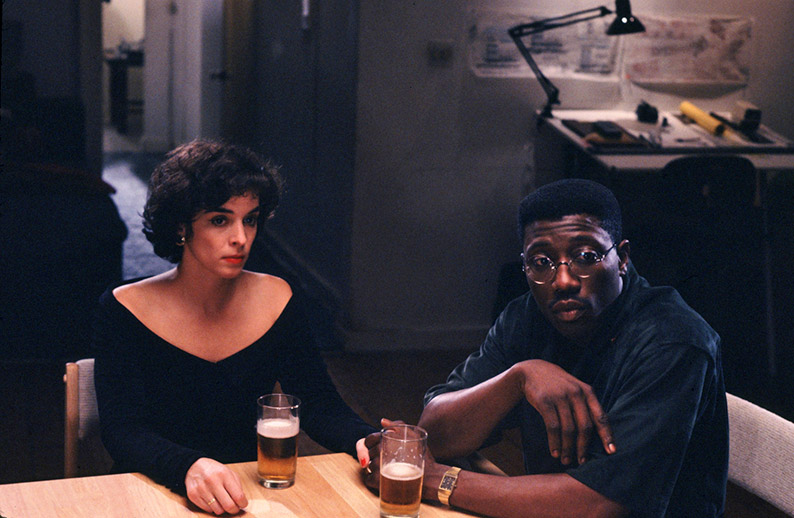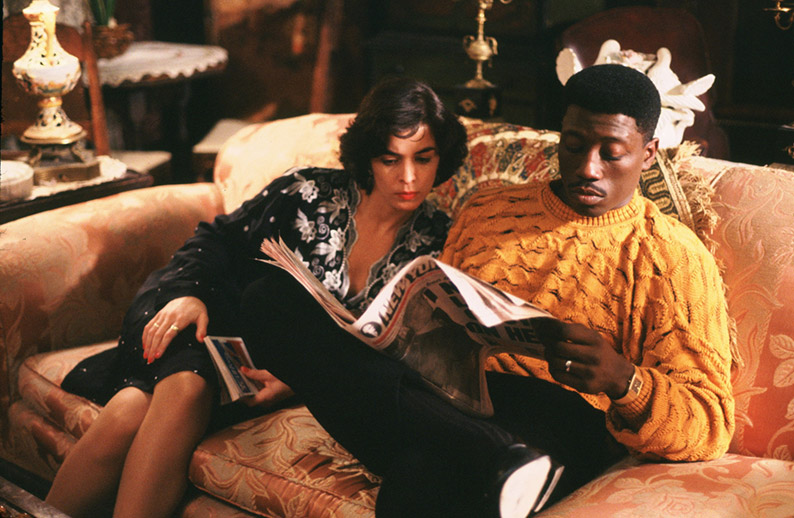|
New York City. Flipper Purify (Wesley Snipes), Flip for short, has a well-paid job in an architecture firm, though he can’t quite get the promotion he thinks he deserves – maybe because he’s the only man of colour working there. He is married to Drew (Lonette McKee) and they have a daughter, Ming (Veronica Timbers). As if to emphasise how happily married Flip and Drew are, Spike Lee begins the film with a scene of their lovemaking, and cinematographer Ernest Dickerson (who worked with Lee from student days until Malcolm X, after which he became a director himself) bathes it all in a warm orange glow.
Angie Tucci (Annabella Sciorra) is an Italian-American from Bensonhurst. She starts a job at the same architecture firm as Flip’s secretary. There’s an attraction between them and they begin an affair, but the results are certainly unexpected.
Jungle Fever was Lee’s fifth feature film, and the third of a run of five he made for those studios, interrupted only by his next film, Malcolm X, which was made at Warners. Thirty years later, you have to wonder how many of those films would be made by majors nowadays, at the risk of sounding old...but they were, and this was a wide release. All of Lee’s films to this point had been made for not-huge budgets and, while more or less successful, all turned a profit. He also had final cut on all his films, something that was only challenged with the much bigger-budget Malcolm X, due to its three-and-a-quarter-hour length.

If Do the Right Thing had been a film which made audiences sit up and take notice, Lee’s next film Mo’ Better Blues had been a lower-key piece about jazz musicians, made in part in tribute to his father, jazz bassist Bill Lee. However, Jungle Fever returns us to Lee to the here and now in intentionally provocative mode, brash and bold and more than a little sprawling at two and a quarter hours. Everyone in the film is marked by Angie and Flip’s affair, in both the city’s African-American and Italian-American communities. Not least Drew, who throws Flip out of the house. (You do wonder, though, if the bigger sin of the affair is the fact that it’s interracial than that it’s a marital infidelity on his part.) Fathers disown their children. And people begin to worry about their own ethnicity, including lighter-skinned African Americans (such as Drew and Ming) and darker-skinned Italians.
Jungle Fever has many scenes which are powerfully written and performed, with Lee’s dialogue pungent and often profane. (This film did hold the record, along with Goodfellas, for most “fucks” in a major-studio release, though it’s long since been surpassed.) What it isn’t, however, is a shapely narrative. Despite scenes with her girlfriends, and a sequence where Drew and her female friends vent their grievances about the men in their lives (mostly improvised by the cast: you can tell), the film is more about the men than the women. The romance/affair (you decide which: Sciorra and Lee disagreed over this) in the second half of the film is partly sidelined by a second plot line based around Flip’s drug-addicted older brother Gator (Samuel L. Jackson). While you can see the parallels between the two stories – both stories of sons straying from the path, in the eyes of their father (Ossie Davis), a reverend – they compete rather than play off each other. However, one of the best scenes in the film, and one of the best sequences Lee had made up to that point, belongs to this storyline, as Flip goes into a crack den to retrieve Gator while Steve Wonder’s “Livin’ in the City” plays out on the soundtrack. Wonder had composed several new songs for the film, all of which Lee used, including the title track, but this song was an existing one, and it’s used to powerful effect, with Dickerson taking the filters away to give the sequence a much colder look. As well as Wonder’s songs, the film has a music score by Terence Blanchard. This was a breakthrough performance from Jackson, who won a rarely-awarded Best Supporting Actor prize at Cannes.

Three decades later, Lee’s career has had its hits and misses, and changes in Hollywood have meant that for the last decade or so, he has worked independently of the studios. His most recent feature as I write this, Da 5 Bloods, was made for Netflix. However, Jungle Fever remains one of his key films of the early 1990s. It’s messy and uneven, but for a work that means to ask questions and provoke debate, that’s possibly to be expected. But at the end, Lee suggests, something has been broken – the final scene is a literal cry of despair.
The BFI’s Blu-ray release of Jungle Fever is encoded for Region B only.
The transfer is in the intended aspect ratio of 1.85:1 from a HD master supplied by NBC Universal. The film dates from the pre-digital days, so it was shot on colour 35mm stock, and there’s nothing untoward about this transfer: faithful to Lee and Dickerson’s often heightened colour scheme (such as those orange filters) and faithful to what I remember seeing on the film original UK cinema release.
The film was made a couple of years before digital soundtracks became widespread, and on this Blu-ray it’s rendered as LPCM 2.0, which plays in (non-split) surround, with the surround speakers largely devoted to the music, with some ambience and the occasional directional effect. English subtitles for the hard-of-hearing are available and I didn’t spot any errors in them.
Commentary by Jim Hemphill
Newly produced for this release, this commentary is the work of a self-confessed Spike Lee fanboy, as the man was a god to many film students and would be filmmakers, including him. Hemphill has no difficulty filling a longer-than-usual feature running time, and this is a very thorough piece on the making of the film, its place in Lee’s career and the conclusions the films draws.
The Independent Interview with Spike Lee (73:37)
Lee is interviewed on stage at the BFI Southbank by David Lammy MP. This item dates from 2009, as part of a season, “Fight the Power: Do the Right Thing in Context”, for that film’s twentieth anniversary. Needless to say, Lammy and Lee’s conversation is mostly about Do the Right Thing though there’s discussion about Lee’s wider career. When asked “how he did it”, Lee glances at his watch and more or less asks “How long have you got?” before acknowledging the work of his regular collaborators. As usual with these recordings, pauses in the proceedings to show film extracts have been edited out and there are questions from the audience.

Archive featurette (7:43)
A brief making-of from the film’s original release, this takes the usual form of a mixture of interviews (with Lee, Snipes, Sciorra and Davis), on-set footage and clips from the film. It does cover more ground than you would expect, given the short running time. In standard definition in a ratio of 1.33:1.
Theatrical trailer (2:37)
A green-band trailer, selling the film on its comedy and the romance, with what would be spoilers if you knew them in context.
Image gallery (4:12)
Self-navigating, with twenty-nine colour production stills.
Top Deck (29:52)
Another BFI extra, again taking one of the themes of the main feature – in this case, interracial romance – and running with it. A white bus conductor (Ruth D’Arcy) falls for one of her regular passengers, a black US Air Force serviceman (James Anderson). They begin an affair, to raised eyebrows from her neighbours, but it doesn’t last. It was directed for the BFI, in 16mm black and white, by David Andrews, then an actor, who was to continue in a forty-year career as a television director. (He also appears as “man getting off bus”, uncredited.) The film was written by John Arden, who had become a major English playwright towards the end of the 1950s, particularly with his play Serjeant Musgrave’s Dance, premiered on stage in 1959 and adapted for television several times since. The odd thing is that this very theatrical writer wrote this short film which has no spoken dialogue at all: it’s effectively a no-intertitle silent film, with just a Norman Cave jazz score and sound effects (including some diegetic background chatter) on the soundtrack. The lead characters are called Marlene and Johnny in the credits but not on screen. And here’s a little mystery. This film is the only IMDB entry for both lead actors (some more familiar names, such as Bryan Pringle, show up in small roles) but http://homepage.eircom.net/~artpeople/biography.htm suggests that the lead role was played by Margaretta D’Arcy, who most usually acted under that name but whose middle name is Ruth, Arden’s wife and later collaborator on some of his plays. Presented in 1.33:1.

Booklet
Available with the first pressing only, the BFI’s booklet runs to thirty-two pages. It begins with an essay by Kambole Campbell, “Jungle Fever and Spike Lee’s Alternative Black Livelihoods” (spoiler warning), which begins by agreeing with me that the film would be unlikely to be made today, not as a wide-release major studio production at least. He discusses Lee’s look at black middle class characters, though systemic racism is not far away. (The two cops who disrupt Flip and Angie’s argument, assuming that he’s assaulting her, are played by the same actors who carry out the killing which sparks off the riot in Do the Right Thing.) He contrasts Flip’s lifestyle with that of Gator’s, ending up with Flip’s excursion into the part of town his income had protected him from.
Next up is a 1991 piece from Armond White first published in Sight & Sound, “Jungle Fever in Context: Flipper Purify and Furious Styles” which considers Lee’s film with others made by African American directors, often debuts, around the same time, specifically Jungle Fever, John Singleton’s Boyz N the Hood, Matty Rich’s Straight Out of Brooklyn and Wendell B. Harris’s Chameleon Street.
Kaleem Aftab takes a look at mixed-race relationships on screen, beginning with West Side Story, an early favourite film of Lee’s, hopping over the Atlantic for A Taste of Honey and hopping back again for Guess Who’s Coming to Dinner, which displayed a generational shift in finding the relationship wholly positive. He suggests that in Lee’s film the relationship is as much about testing stereotypes as it could be about love. Also in the booklet are notes on the extras, full film credits and stills.
Thirty years on from its release, Jungle Fever remains an ambitious, sprawling, certainly uneven but often powerful film, and a key work of Spike Lee’s early career.
|